Caelum constellation is located in the southern hemisphere. It represents an engraver’s chisel. Its name is the Latin word for “the chisel.” The small, faint constellation was originally named Caelum Sculptoris, the sculptor’s chisel. It is one of the 14 constellations created by the French astronomer Nicolas Louis de Lacaille in the 18th century.
Caelum does not contain any prominent deep sky objects and has only two stars brighter than fifth magnitude. The constellation’s brightest star, Alpha Caeli, shines at magnitude 4.456 and is difficult to see from light-polluted areas.
The constellation is home to the faint eclipsing binary star RR Caeli and the red dwarf LHS 1678, which hosts three exoplanets. Deep sky objects in Caelum include the unusual quasar HE0450-2958, notable for appearing to lack a host galaxy, and the galaxies NGC 1679, IC 2106, NGC 1570, the Carafe Group, and the Trekkie Galaxy (NGC 1701).
Facts, location and map
Caelum is the 81st largest (or the eighth smallest) constellation in the sky, occupying an area of only 125 square degrees of the southern sky. It lies in the first quadrant of the southern hemisphere (SQ1). The entire constellation can be seen from locations between the latitudes +40° and -90°.
The neighboring constellations are Columba, Dorado, Eridanus, Horologium, Lepus, and Pictor.
The constellation name Caelum is pronounced /ˈsiːləm/. In English, the constellation is known as the Engraving Tool or the Chisel. The genitive form of Caelum, used in star names, is Caeli (pronunciation: /ˈsiːlaɪ/). The three-letter abbreviation, adopted by the International Astronomical Union (IAU) in 1922, is Cae.
Caelum does not have any stars brighter than magnitude 3.00 or located within 10 parsecs (32.6 light years) of Earth.
The brightest star in Caelum is the yellow-white dwarf Alpha Caeli with an apparent magnitude of 4.456.
The nearest star, the orange dwarf HD 30876, has the spectral class K2V and lies at a distance of 57.86 light years from Earth.
Caelum does not contain any named stars. There are no meteor showers associated with the constellation.
Caelum belongs to the Lacaille family of constellations, along with Antlia, Circinus, Fornax, Horologium, Mensa, Microscopium, Norma, Octans, Pictor, Reticulum, Sculptor, and Telescopium.
Caelum contains several stars with confirmed exoplanets. These include the eclipsing binary RR Caeli, the yellowish-orange dwarf HD 30669, and the F-type subgiant WASP-159 with one planet each, and the red dwarf LHS 1678 with three planets.
The best time of the year to see the constellation Caelum is during the month of January, when it appears higher above the horizon around 9 pm.
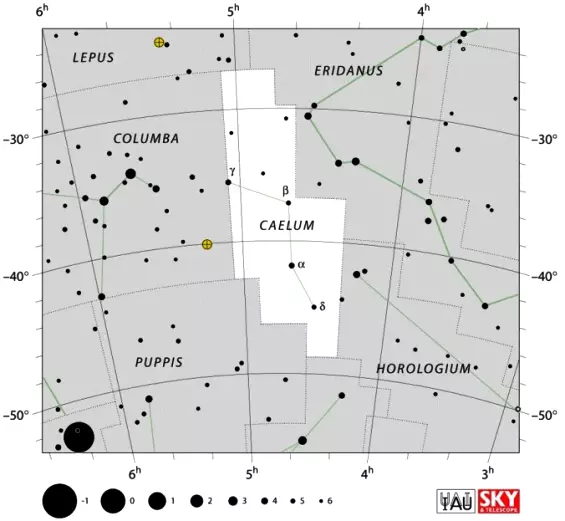
Caelum constellation map by IAU and Sky&Telescope magazine (Roger Sinnott & Rick Fienberg) (CC BY 3.0)
Story
There are no myths associated with Caelum. Unlike the ancient constellations catalogued by Claudius Ptolemy in his Almagest, Caelum was not named after a mythological figure. It is one of the 14 constellations introduced by the French astronomer Lacaille in the 1750s. While the Latin word caelum also means “sky” or “heaven,” the small constellation is not associated with this meaning.
Lacaille named his constellations after various instruments and tools. The constellations introduced by the French astronomer include Antlia (the Air Pump), Circinus (the Compass), Horologium (the Pendulum Clock), Microscopium (the Microscope), Norma (the Level or the Carpenter’s Square), Octans (the Octant), and Telescopium (the Telescope).
Caelum is depicted as a sculptor’s chisel. It first appeared on Lacaille’s map of the southern stars published in 1756. The constellation was named “les Burins” and depicted as a pair of crossed burins – a standard burin and an échoppe – connected by a ribbon. (Burins are sharp engraving tools.) The name was translated into Latin as Caelum Sculptoris in Lacaille’s 1763 catalogue.
The name was shortened to Caelum by the English astronomer Francis Baily at the suggestion of the German-born British astronomer Sir William Herschel.
In Johann Bode’s star atlas Uranographia (1801), the constellation still had the longer name, Caela Scalptoris (the Engraver’s Chisels), stated in plural.

Photo of the constellation Caelum with annotations from IAU and Sky & Telescope. Image credit: E. Slawik/NOIRLab/NSF/AURA/M. Zamani (CC BY 4.0)
Caelum stars
Caelum contains only 20 stars visible to the unaided eye (brighter than magnitude 6.5). It does not host any stars brighter than magnitude 4. Only the constellation’s two brightest stars – Alpha and Gamma1 Caeli – are brighter than magnitude 5. They form the constellation figure of the Chisel with Beta and Delta Caeli.
The brightest stars in Caelum are Alpha Caeli (mag. 4.456), Gamma1 Caeli (mag. 4.57), Beta Caeli (mag. 5.04), Delta Caeli (mag. 5.06), HD 30080 (mag. 5.66), HD 31093 (mag. 5.83), HD 32515 (mag. 5.90), HD 32453 (mag. 6.01), HD 30432 (mag. 6.04), and Nu Caeli (mag. 6.07).
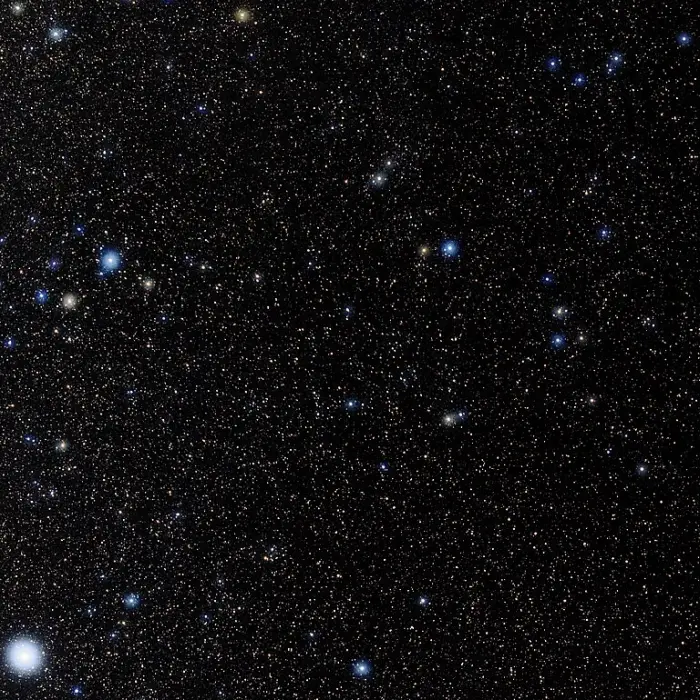
Photo of the constellation Caelum produced by NOIRLab in collaboration with Eckhard Slawik, a German astrophotographer (without annotations). Credit: E. Slawik/NOIRLab/NSF/AURA/M. Zamani (CC BY 4.0)
α Caeli (Alpha Caeli)
Alpha Caeli (α Cae) is the brightest star in Caelum. It shines at magnitude 4.456 from a distance of 66.48 light-years. It has the spectral class F2V, indicating a yellow-white main sequence star.
Alpha Caeli appears as a single star to the unaided eye, but it is in fact a binary system. The bright primary component, Alpha Caeli A, has a much fainter companion, Alpha Caeli B. The companion has an apparent magnitude of 12.5 and is invisible to the unaided eye.
The two components are separated by only 6.6 seconds of arc in the sky, corresponding to a physical distance of 133.1 astronomical units (Earth – Sun distances). They take 1,260 years (460,000 days) to complete an orbit around a common centre of mass.
Alpha Caeli A has a mass of 1.54 solar masses and a radius of 1.546 solar radii. With an effective temperature of 7,002 K, it shines with 5.156 solar luminosities. It has an estimated age of 1.5 billion years. The star spins faster than the Sun. With a projected rotational velocity of 47 km/s, it takes 1.4 days to complete a rotation. It is surrounded by a debris disk that extends to 46 astronomical units (AU) from the star.
Alpha Caeli A is a suspected Delta Scuti variable, a star whose brightness varies due to both radial and non-radial pulsations of its surface. The star’s brightness has been observed to vary between magnitude 4.44 and 4.47.
Alpha Caeli B is a red dwarf of the spectral type M0.5V. It has a radius of 0.45 solar radii and a surface temperature of 3,355 K. Like many other known red dwarfs, it is a flare star. It occasionally undergoes sudden dramatic increases in luminosity that last for a few minutes.
Alpha Caeli is believed to be a member of the Ursa Major moving group (Collinder 285), a stellar association that includes some of the brightest stars in the constellation Ursa Major. These stars formed in the same star cluster at around the same time and share similar velocities and motion through space.
The nearest neighbour of Alpha Caeli is LHS 1678, an M-type dwarf that hosts three orbiting extrasolar planets. The two star systems are separated by only 3.4 light-years, which is less than the distance from the Sun to Proxima Centauri (4.2465 light-years).
γ Caeli (Gamma Caeli)
Gamma Caeli (γ Cae) is a Bayer designation used by two star systems that appear close in the sky but are not physically related. Both visual components are binary stars.
The brighter Gamma1 Caeli (γ1 Cae) is a double star composed of an orange giant of spectral type K2III-IIIb and a yellow subgiant with the stellar classification G8IV.
The K-type giant Gamma1 Caeli A shines at magnitude 4.57 from a distance of 185 light-years, and the G-type subgiant Gamma1 Caeli B lies 187.6 light-years away and has an apparent visual magnitude of 8.07. The fainter component is invisible to the unaided eye.
Gamma1 Caeli A is the second brightest star in Caelum. It is a mass of 1.4 solar masses and a radius 14.31 times that of the Sun. With an effective temperature of 4,411 K, it is 69.9 times more luminous than the Sun. The star is a very slow spinner, with a projected rotational velocity of less than 1 km/s.
Gamma1 Caeli B is the less massive of the pair. It has a mass of 0.91 solar masses and a surface temperature of 5,702 K. The star can be spotted in binoculars.
Gamma2 Caeli (γ2 Cae) is a binary star system composed of a yellow-white main sequence star or subgiant with an apparent magnitude of 6.28 – 6.39 and a fainter companion with an apparent magnitude of 9.65. The stars are separated by 0.890 arcseconds. They lie at an approximate distance of 341 light-years from Earth.
The primary component, Gamma2 Caeli A, has 1.52 times the Sun’s mass and a radius 3.43 times the Sun’s. It is 23.65 times more luminous than the Sun and has an effective temperature of 7,227 K. The star spins at around 69 km/s. It has an estimated age of 961 million years.
Gamma2 Caeli A is classified as a Delta Scuti variable. It has the variable star designation X Caeli. Its brightness varies with a period of 3.25 hours due to pulsations of its surface.
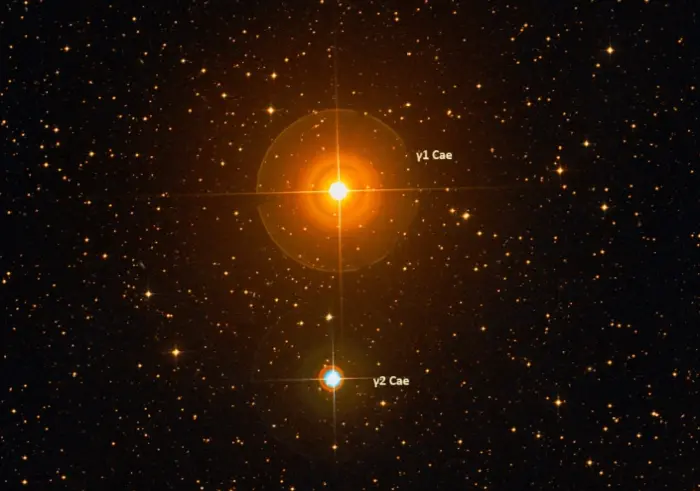
Gamma Caeli, image credit: ESO/Digitized Sky Survey 2 (CC BY 4.0)
β Caeli (Beta Caeli)
Beta Caeli (β Cae) is the third brightest star in Caelum. It has an apparent magnitude of 5.04 and lies 94.2 light-years away.
Beta Caeli is a spectroscopic binary star system composed of a yellow-white subgiant or main sequence star with the spectral class F3 V of F3 IV and a low-mass companion. The components are separated by 4.6 astronomical units and have an orbital period of around 7.5 years. They cannot be resolved, even in very large telescopes.
The primary star, Beta Caeli A, has a mass of 1.482 solar masses and a radius 1.902 times that of the Sun. It has an effective temperature of 6,665 K and an energy output 6.615 times the Sun’s. The star is a fast rotator. With an estimated rotational velocity of 97.5 km/s, it completes a rotation in 0.8669 days.
Estimates of the star’s age are in the range between 0.2 and 1.941 billion years.
The companion, Beta Caeli B, has a mass of 0.08 or 0.2 solar masses and a surface temperature of 3,593 K. It may be a substellar object (a brown dwarf) or a low-mass main sequence star (a red dwarf).
δ Caeli (Delta Caeli)
Delta Caeli (δ Cae) is a hot blue star located approximately 700 light-years away. With an apparent magnitude of 5.06, it is the fourth brightest star in Caelum. It is a very young star, with an estimated age of only 9.4 million years.
Delta Caeli has the stellar classification B2 IV-V, indicating a massive blue star that is nearing the end of its main sequence life. The star has 7.65 times the Sun’s mass and a size of 3.9 solar radii. With an effective temperature of 21,150 K, it shines with 2,578 solar luminosities. Astronomers believe it to be a member of the Milky Way thick disk population.
HD 30080
HD 30080 is an evolved star on the red giant branch (RGB). It has the spectral type K3 III, indicating an orange giant. It shines at magnitude 5.66 from a distance of 612 light-years.
HD 30080 has a mass comparable to the Sun – 1.16 solar mass – but has expanded to a size of 41.62 solar radii as it evolved into a giant. It has a surface temperature of 4,262 K and an energy output of 299 Suns. The star is a slow spinner, with a projected rotational velocity of up to 1 km/s.
HD 31093
HD 31093 is a double star with a combined apparent magnitude of 5.83. It lies around 268 light-years away.
Both components in the binary system are A-type main sequence stars. They have the spectral types A1V and A4V. The stars have an orbital period of 43.36 years and are separated by only 0.248 arcseconds in the sky. The primary component has a mass of 1.85 solar masses and the secondary, 1.58 solar masses.
HD 32514
HD 32515 is an orange giant located 324 light years away. It has an apparent visual magnitude of 5.90. It is around 4.49 billion years old.
The star has a mass of 1.52 solar masses and a radius 11.9 times that of the Sun. It is 56.3 times more luminous than the Sun and has an effective temperature of 4,540 K. It spins at 1.4 km/s.
HD 32453
HD 32453 is a yellow giant star located 407 light-years away. With an apparent magnitude of 6.01, it is barely visible to the unaided eye in exceptionally good conditions. It has the stellar classification G8 III.
The star has a mass 2.40 times that of the Sun has expanded to a size of 10.03 solar radii as it evolved into a giant. It has a surface temperature of 5,032 K and is 50.1 times more luminous than the Sun.
HD 32453 spins at 2 km/s. It has an estimated age of 700 million years.
HD 30432
HD 30432 is an orange giant of the spectral type K1 III. It shines at magnitude 6.04 from a distance of 310.5 light years. It is believed to be around 455 million years old.
The giant star has a mass of 2.80 solar masses and a radius 9.55 times that of the Sun. With an effective temperature of 4,758, it shines with 38.9 solar luminosities. It spins slowly, at under 1.3 km/s.
The star is currently on the red giant branch. It has an inert helium core and is fusing hydrogen in a shell around the core.
ν Caeli (Nu Caeli)
Nu Caeli (ν Cae) is a yellow-white star located 160.9 light-years away. It has an apparent magnitude of 6.07. It has been classified as a main sequence star or a subgiant/giant.
The star has an estimated age of 880 million years. It has 134% of the Sun’s mass and a radius 2.107 times that of the Sun. With a surface temperature of 6,696 K, it has an energy output 8.011 times that of the Sun. It spins at 44.9 km/s.
LHS 1678
LHS 1678 is an astrometric binary star composed of a red dwarf of spectral type M2V and a fainter companion. The invisible companion may be a brown dwarf or a Jovian planet. Its presence can only be inferred from the primary component seemingly orbiting around a point in space.
The two components are separated by up to 5 astronomical units. They lie 64.79 light-years away. With an apparent magnitude of 12.482, the star system is invisible to the unaided eye.
The primary star, LHS 1678 A, has a mass of 0.345 solar masses and a radius of 0.329 solar radii. With a temperature of 3,490 K, it shines with only 0.0145 solar luminosities. The star takes around 66 days to complete a rotation. It has an estimated age of 4.22 billion years.
LHS 1678 A hosts three confirmed extrasolar planets, discovered in 2022 and 2024. All three planets are smaller than Earth and orbit close to their host star. They have orbital periods of 21 hours, 3.7 days, and 5 days and estimated masses of 0.26, 0.81 and 0.92 Earth masses.
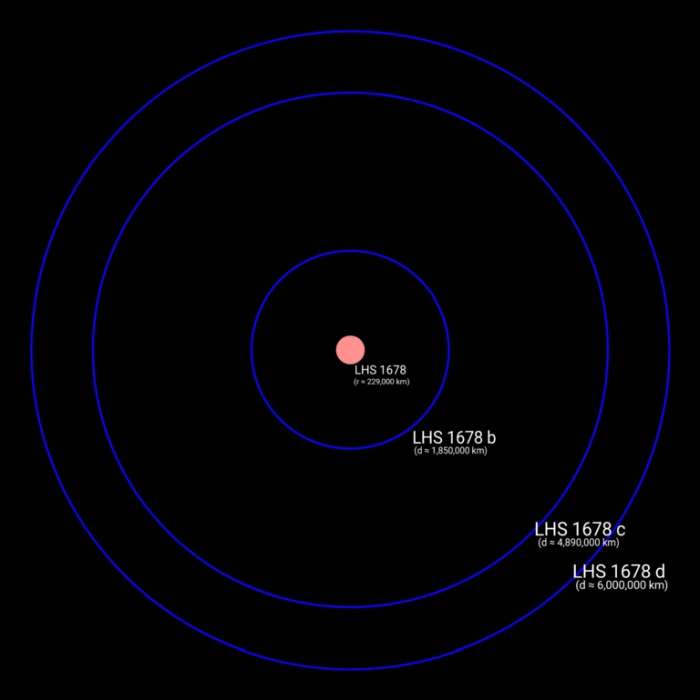
The LHS 1678 planetary system is made up of three planets, LHS 1678 b, c and d. Image credit: Wikimedia Commons/InTheAstronomy32 (CC0 1.0)
RR Caeli
RR Caeli is an eclipsing binary star composed of a red dwarf of the spectral type M4 V and a white dwarf with the spectral class DA7.8. The system lies 69.10 light years away. With an apparent magnitude of 14.40, it is well below unaided eye visibility.
Much like the Algol system in the constellation Perseus, the components of RR Caeli periodically eclipse each other as they orbit around a common centre of mass. They take 7.289 hours to complete an orbit. The eclipses cause the system’s brightness to drop for about 10 minutes.
The white dwarf is the more massive of the two components. It has a mass of 0.453 solar masses, while the red dwarf has a mass of 0.168 solar masses. However, the red dwarf is larger, with a radius of 0.203 – 0.215 solar radii. The white dwarf packs its mass into a radius of 0.01568 solar radii.
The red dwarf is transferring material onto the accreting white dwarf. In another 9 – 20 billion years, the white dwarf will accumulate enough material to cause a classical nova outburst or possibly even trigger a Type I supernova event.
The RR Caeli system may host two circumbinary planets (planets orbiting both components instead of only one). The first planet, RR Caeli b, was reported in 2012. It has a mass of 4.2 Jupiter masses and orbits the star system at a distance of 5.3 AU with a period of 11.9 years. A two-planet model was proposed for the system in 2021.
Deep sky objects in Caelum
Caelum does not have any prominent deep sky objects. It lies away from the plane of the Milky Way and its brightest deep sky objects are only several faint galaxies and nebulae that are challenging targets for small and medium telescopes.
Caelum does not contain any Messier objects or any objects listed in the Caldwell and Herschel 400 catalogues.
NGC 1679
NGC 1679 is a barred spiral galaxy located two degrees south of Zeta Caeli. It has an apparent magnitude of 11.6 and an apparent size of 2.7 by 2.0 arcminutes. It was discovered by the English astronomer John Herschel on November 18, 1835.
The galaxy lies at an approximate distance of 36.9 million light years from Earth.
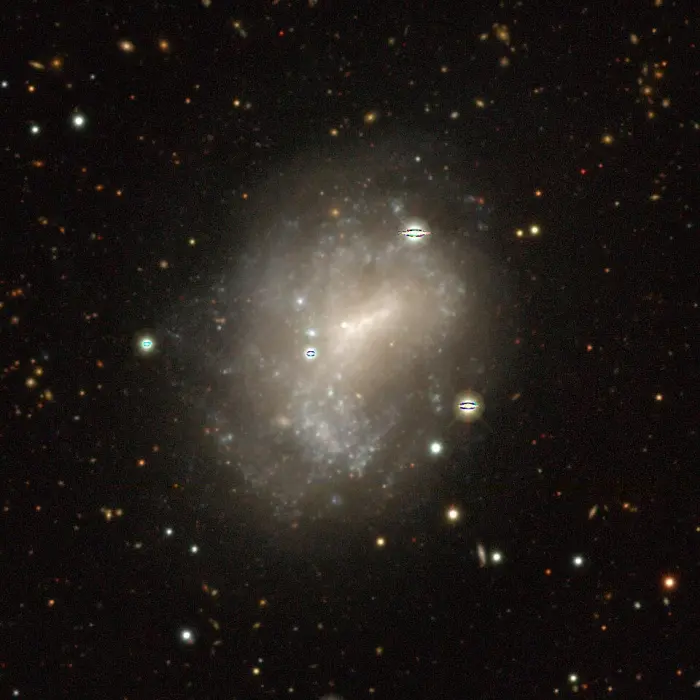
NGC 1679 with Legacy Surveys DR10, image credit: Legacy Surveys / D. Lang (Perimeter Institute), NERSC, Meli Thev (CC BY-SA 4.0)

NGC 1679 in Caelum, based on observations made with the NASA/ESA Hubble Space Telescope, and obtained from the Hubble Legacy Archive, which is a collaboration between the Space Telescope Science Institute (STScI/NASA), the Space Telescope European Coordinating Facility (ST-ECF/ESA) and the Canadian Astronomy Data Centre (CADC/NRC/CSA) (CC BY-SA 3.0)
IC 2106
IC 2106 is a barred spiral galaxy with an apparent visual magnitude of 13.0 and an angular size of 1.7 by 0.9 arcminutes. It lies approximately 228.6 million light-years away. It was discovered by the American astronomer Lewis Swift on December 26, 1897.
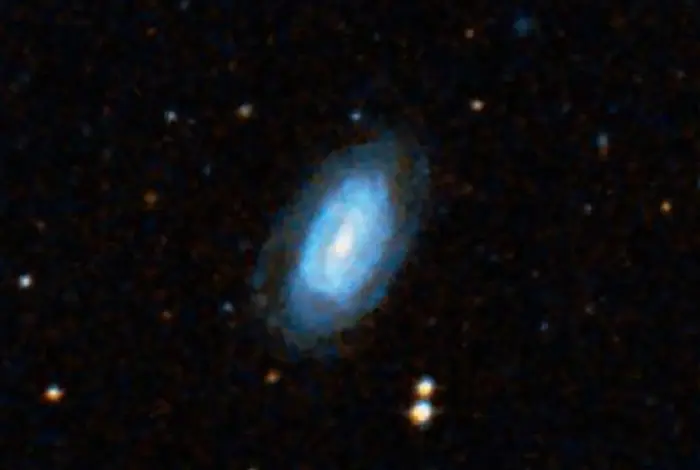
IC 2106, image credit: ESO/Digitized Sky Survey 2 (CC BY 4.0)
NGC 1570
NGC 1570 is a lenticular galaxy located 199 million light years away. It has a double listing in the New General Catalogue and is sometimes referred to as NGC 1571. It is the brightest member of a small group of galaxies called LDC 302.
The galaxy has an apparent magnitude of 13.22 and an apparent size of 1.037 by 0.809 arcminutes, corresponding to a physical diameter of 108,000 light-years. Some sources classify it as a peculiar elliptical galaxy.
NGC 1570 was discovered by John Herschel on December 4, 1836. It can be seen in a medium-sized telescope.
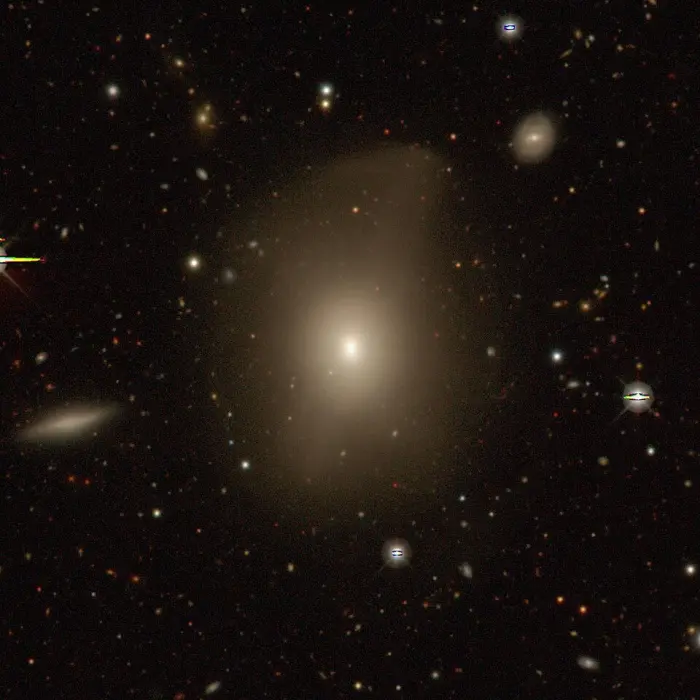
NGC 1570 with Legacy Surveys DR10, image credit: Legacy Surveys / D. Lang (Perimeter Institute), NERSC, Meli Thev (CC BY-SA 4.0)
Trekkie Galaxy (NGC 1701)
The Trekkie Galaxy is an unbarred spiral galaxy located 281 million light-years away. It has an apparent visual magnitude of 12.8 and an apparent size of 1.2 by 0.9 arcminutes. Its popular nickname is a reference to the registry of the USS Enterprise (NCC-1701) in the Star Trek series.
The galaxy was discovered by John Herschel on November 6, 1834. With a diameter of 171,000 light-years, the galaxy is much larger than the Milky Way.
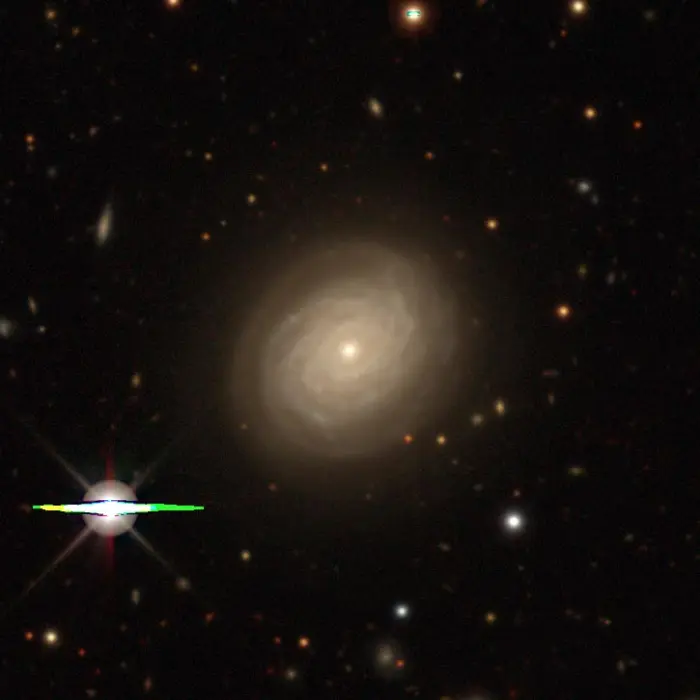
The Trekkie Galaxy (NGC 1701) with Legacy Surveys DR10, image credit: Legacy Surveys / D. Lang (Perimeter Institute), NERSC, Meli Thev (CC BY-SA 4.0)
NGC 1616
NGC 1616 is an intermediate spiral galaxy located approximately 213 million light-years from the Sun. It was discovered by John Herschel on October 24, 1835.
The galaxy is 116,000 light-years across. It has an apparent magnitude of 12.5 and an angular size of 1.905 by 1 arcminutes.
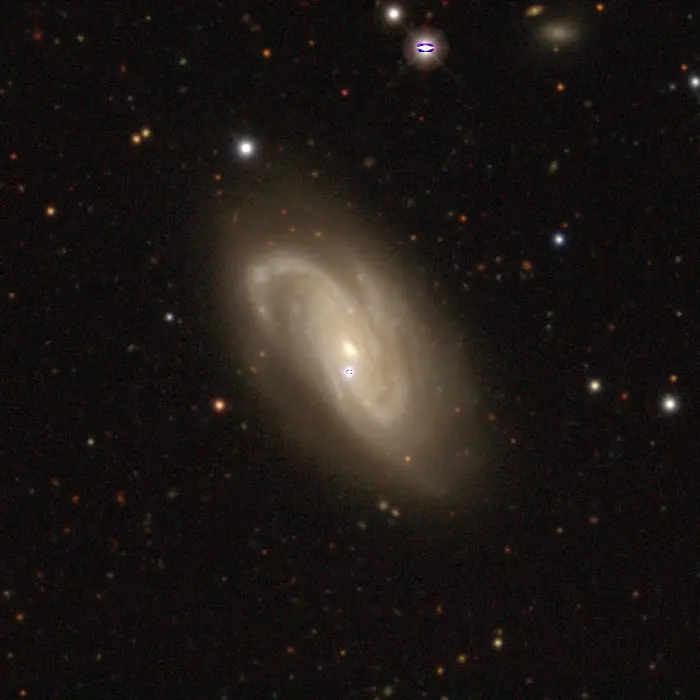
NGC 1616 with Legacy Surveys DR10, image credit: Legacy Surveys / D. Lang (Perimeter Institute), NERSC, Meli Thev (CC BY-SA 4.0)
PGC 16389
PGC 16389 (LEDA 16389) is a dwarf irregular galaxy located 21.6 million light-years away. It has an apparent magnitude of 14.4 and an apparent size of 1.3 by 1.3 arcminutes.
PGC 16389 overlaps its neighbour, the edge-on galaxy APMBGC 252+125-117. The galaxies only appear in the same line of sight and are not interacting.

At first glance, this Hubble picture appears to capture two space colossi entangled in a fierce celestial battle, with two galaxies entwined and merging to form one. But this shows just how easy it is to misinterpret the jumble of sparkling stars and get the wrong impression — as it’s all down to a trick of perspective. By chance, these galaxies appear to be aligned from our point of view. In the foreground, the irregular dwarf galaxy PGC 16389 — seen here as a cloud of stars — covers its neighbouring galaxy APMBGC 252+125-117, which appears edge-on as a streak. This wide-field image also captures many other more distant galaxies, including a quite prominent face-on spiral towards the right of the picture. Image credit: ESA/Hubble & NASA; Acknowledgement: Luca Limatola (CC BY 3.0)
NGC 1585
NGC 1585 is a spiral galaxy located approximately 223 million light-years away. It has an apparent visual magnitude of 13.5. It appears near the variable star RV Caeli in the sky. The lenticular galaxy IC 2068 appears in the same region of the sky.
The galaxy is 129,400 light-years across. It has an active galactic nucleus and is classified as a Seyfert type I galaxy.
NGC 1585 was discovered by John Herschel on December 1, 1837. A supernova was observed in the galaxy in 2023. The supernova, SN 2023vio, was classified as a type Iax supernova and shone at magnitude 19.053. It was discovered on October 17, 2023.
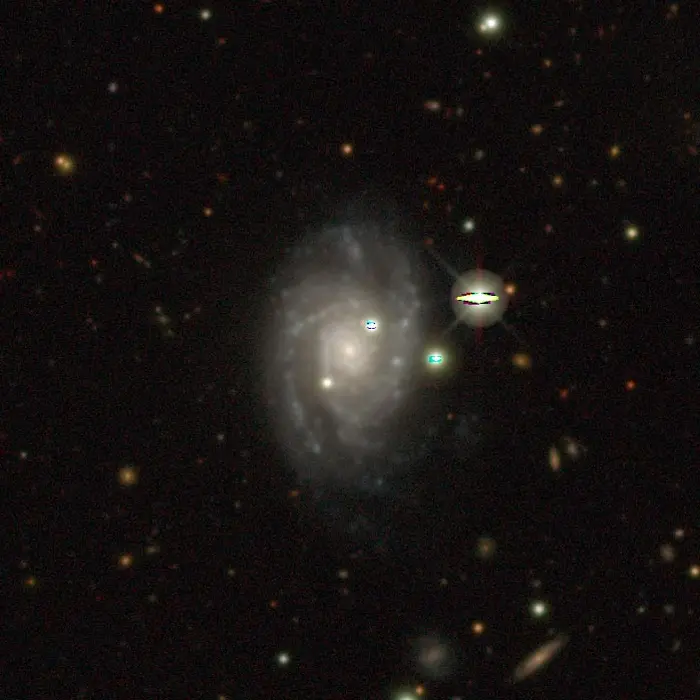
NGC 1585 with Legacy Surveys DR10, image credit: Legacy Surveys / D. Lang (Perimeter Institute), NERSC, Meli Thev (CC BY-SA 4.0)
HE 0450-2958
HE 0450-2958 is a quasar that appears to not have a host galaxy. It lies approximately 3 billion light-years from the Sun and has an apparent magnitude of 16.0. It appears close to a perturbed starburst galaxy in the sky, but there are no galaxies around the quasar itself. Astronomers believe that the host galaxy is present, but very faint and difficult to see next to the bright light from the quasar.
In 2010, deep near-infrared imaging revealed a blob, a compact emission region, close to the quasar. The blob is believed to be an off-centre compact host galaxy that is currently in the process of colliding with a close companion.
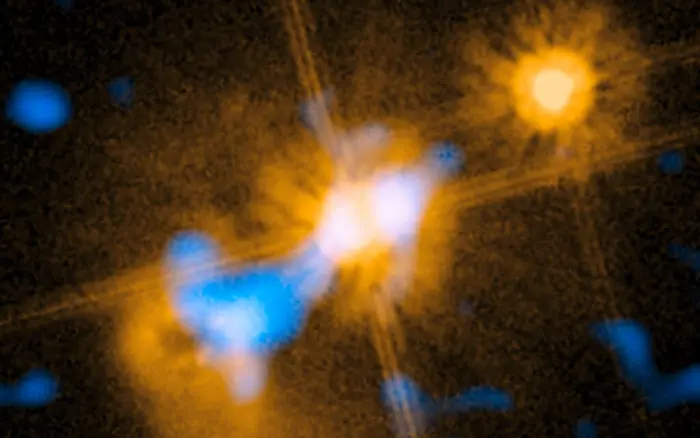
Colour composite image of a peculiar object, the nearby quasar HE0450-2958, which is the only one for which no sign of a host galaxy has yet been detected. A team of astronomers has identified black hole jets as a possible driver of galaxy formation, which may also represent the long-sought missing link to understanding why the mass of black holes is larger in galaxies that contain more stars. The mid-infrared part of this image was obtained with the VISIR instrument on ESO’s Very Large Telescope, while the visible image comes courtesy of the Hubble Space Telescope and the Advanced Camera for Surveys. Image credit: ESO (CC BY 4.0)
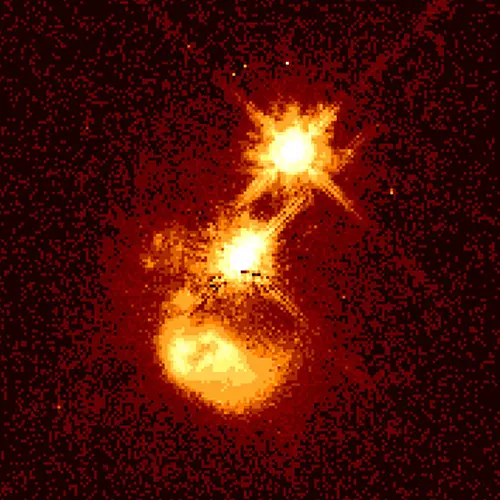
The photo reveals evidence of a collision between two galaxies traveling at about 1.5 million km/hour. The debris from this collision may be fueling quasar IRAS04505-2958, which is 3 thousand million light-years from Earth. Quasars reside in a variety of galaxies, from normal to highly disturbed. When seen through ground-based telescopes, these compact, enigmatic light sources resemble stars, yet they are thousand of millions of light-years away and several hundred thousand million times brighter than normal stars. Astronomers believe that a quasar turns on when a massive black hole at the nucleus of a galaxy feeds on gas and stars. As the matter falls into the black hole, intense radiation is emitted. Eventually, the black hole will stop emitting radiation once it consumes all nearby matter. Then it needs debris from a collision of galaxies or another process to provide more fuel. Image credit: John Bahcall (Institute for Advanced Study, Princeton) Mike Disney (University of Wales) and NASA/ESA (CC BY 4.0)
Carafe Group (NGC 1595, NGC 1598 and ESO 202-23)
The Carafe Group is a small group of galaxies consisting of the Carafe Galaxy (ESO 202-23), the elliptical galaxy NGC 1595, and the spiral galaxy NGC 1598. The trio was discovered by John Herschel on December 3, 1837.
The Carafe Galaxy is a 12th magnitude peculiar spiral galaxy with a vast tidal tail. It has an active galactic nucleus and has been classified as a LINER (low-ionization nuclear emission-line region) galaxy and a Seyfert II galaxy. It lies approximately 230 million light-years away. The galaxy appears distorted by the interaction with NGC 1595.
NGC 1595 and NGC 1598 lie at similar distances, 225 and 240 million light-years, respectively.
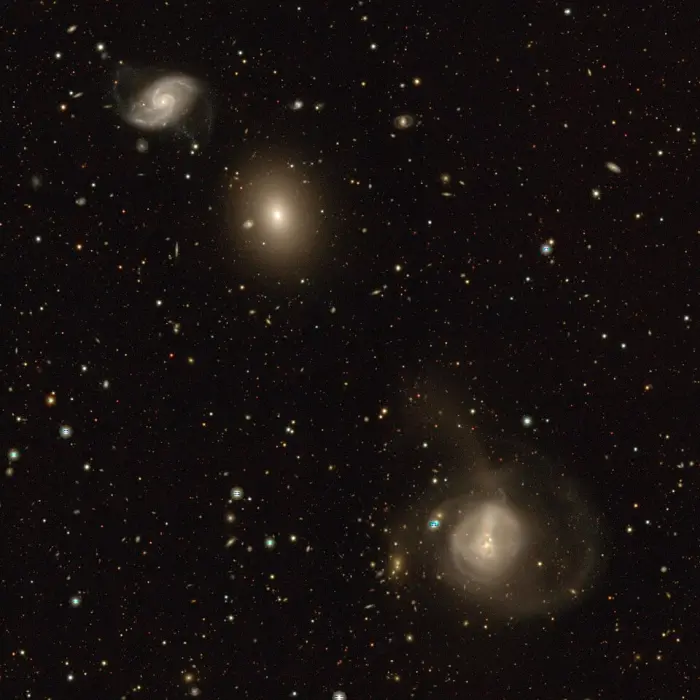
Carafe Galaxy (ESO 202-23, AM 0426-480), NGC 1595 and NGC 1598, with Legacy Surveys DR10, credit: Legacy Surveys / D. Lang (Perimeter Institute), NERSC (CC BY-SA 4.0)